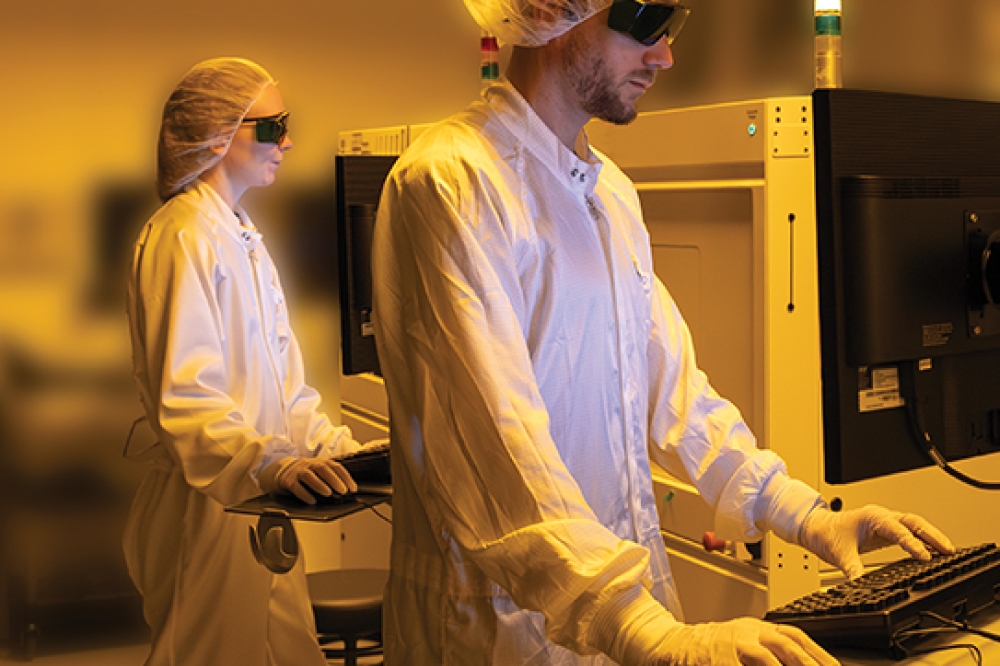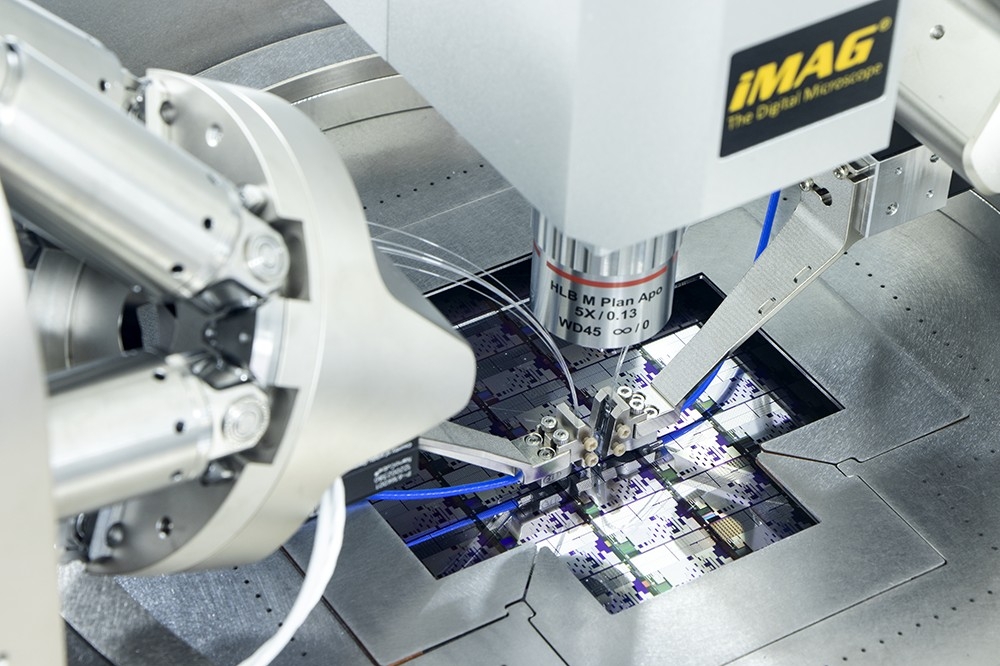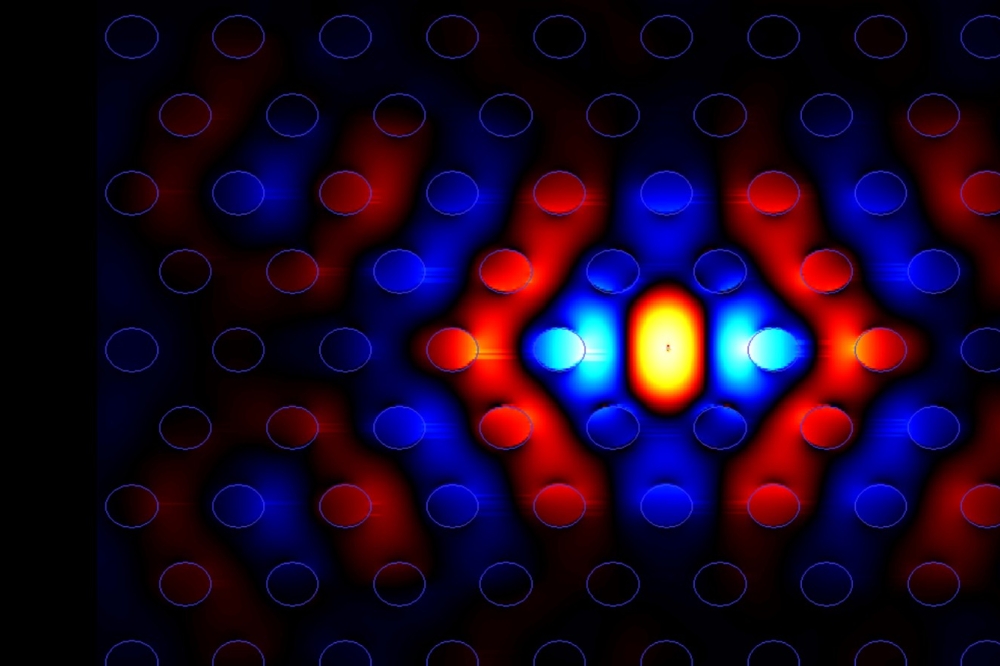
The essential link in next-generation optical connectivity

With industry-ready 3D nano-printing solutions, Vanguard Automation is lighting the path to scalable and reliable processes for integrating active components to PICs.
By Laura Horan and Mo Lu, Vanguard Automation GmbH
Demand is surging for high-performance optics and PICs, driven by AI, datacom, and quantum technologies. LightCounting’s recent report on Optics for AI Clusters forecasts that the market for optical transceivers used in AI clusters will double from $5 billion in 2024 to over $10 billion by 2026 [1]. This underscores how the AI megatrend is reshaping traditional manufacturing, placing pressure on the industry to deliver optical assemblies that ensure precision, reliability, and cost-efficiency at scale.
But there’s a major complication in meeting these needs: next-generation designs for photonic products often combine active and passive components in hybrid systems, fabricated on diverse material platforms such as indium phosphide (InP), silicon nitride, silicon, and thin-film lithium niobate (TFLN). Each of these materials has distinct mode-field characteristics and packaging requirements, and integrating active components like edge-emitting lasers into passive PIC materials for hybrid photonics remains a challenge for the industry.
Figure 1. SEM image of a single-mode fibre (SMF) array aligned to an AMF
chip and integrated using Photonic Wire Bonds. This assembly type has
demonstrated 100 percent yield across 180 connections, with insertion
losses consistently below 2 dB and an average of 1.4 dB—highlighting the
reliability of passive photonic integration packaging.
Traditional active alignment techniques enable accuracy down to sub-micron precision, meeting the stringent requirements for mode-field matching and alignment tolerances that are needed to ensure highly efficient signal transmission. But these methods are labour-intensive and difficult to scale from single to multi-channel arrays. This means that packaging costs can amount to up to 80 percent of the cost of the final product, representing a significant barrier to manufacturing.
At Vanguard Automation, we take a different approach; by combining passive alignment techniques and machine vision with high-precision and fully automated 3D nano-printing, we develop scalable and high-throughput manufacturing solutions for hybrid photonic integration. Headquartered in Karlsruhe, Germany, and now a part of Mycronic, a global supplier of high-precision manufacturing tools, Vanguard Automation is uniquely positioned to deliver advanced manufacturing tools to the market.
Across datacentre, telecommunication, and AI applications, a range of users [2] working on various material platforms have proven that Vanguard Automation’s novel processes can deliver the innovation and scalability needed to unlock the full potential of hybrid photonic integration [3].
Figure 2. SEM image showing facet-attached micro-lenses precisely
3D-printed onto the edge of an AMF chip, demonstrating in-situ
fabrication for compact, alignment-tolerant photonic integration.
Automated nano fabrication
Vanguard’s solution uses highly precise direct-write 3D laser lithography to print 3D freeform optics in-situ at the chip level, eliminating the need for active alignment and enabling passive pick-and-place assembly. The printed optics allow for mode-field matching between dissimilar materials and components, as well as compensating for manufacturing variations by relaxing alignment tolerances. Vanguard Automation offers a robust portfolio of photonic interconnect structures – most notably Photonic Wire Bonds and facet-attached micro-lenses – engineered to support versatile and scalable photonic integration across a wide range of packaging scenarios. This empowers photonic product designers and manufacturing teams to fully leverage efficient assembly build-up in volume manufacturing.
Photonic Wire Bonds (PWBs), shown in Figure 1, are single-mode freeform optical waveguides printed between two photonic components, that compensate for misalignment of up to ±20 µm. This ensures optimal coupling between dissimilar photonic components and enables passive alignment during assembly. PWBs are increasingly recognised as the preferred solution for hybrid integration of active devices such as III-V lasers, quantum-dot lasers, and amplifiers onto passive PIC material platforms [4-6].
In recent demonstrations, PWBs achieved insertion losses as low as 1 dB per interface and supported stable, mode-hop-free laser operation exceeding 58 hours.
Even more impressively, the Vanguard system can complete fibre-to-chip-to-laser integration in a single fabrication step. To achieve this, the system uses machine vision to detect the individual waveguide positions, and automatically calculates the optimal low-loss PWB interconnect trajectory, including mode-field matching.
Meanwhile, facet-attached micro-lenses (FaMLs) can perform spot size conversion and beam expansion, relaxing alignment tolerances up to ±15 µm, and beam shaping reduces sensitivity to lateral and angular misalignment. This eliminates the need for bulk optics, reducing system footprint and cost while overcoming optical and mechanical challenges in hybrid photonic packaging.
FaMLs are a key component for integration in electro-optical engines that underpin transceivers, co-packaged optics, light engines, and sensing devices. A stand-out example is POET Technologies, which collaborates with Vanguard Automation to integrate 3D printed micro-lenses onto its optical interposers. This collaboration enhances coupling efficiency while preserving POET’s signature wafer-level passive assembly process [7].
Figure 3. Vanguard SYMPHONY: Vanguard Automation’s fully automated
photonic integration and packaging platform, featuring BrightWire3D
software for precision interface detection and VanCore photoresists
engineered for industrial reliability.
With its complementary technology portfolio, Vanguard Automation provides a scalable path for volume-production customers to incorporate 3D-printed optics into their production chain. Starting with hybrid approaches using 3D-printed optical elements and active alignment, the product design can evolve to leverage the full potential for photonic integration. Ultimately, customers can benefit from incorporating PWBs with standard pick-and-placing of components with very relaxed tolerances, while simultaneously ensuring high coupling efficiency, high yields, and high package density.
And there are advantages for foundries too; since PWBs and FaMLs can work with simple inverse taper edge couplers realised by stepper lithography, the chip real estate used for sophisticated couplers can be reduced substantially, paving the way towards a novel and more universal standard for optical coupling [8]. Furthermore, the benefits of PWBs and FaMLs can be combined to form a unique offering to correct highly elliptical laser outputs [9].
This convergence of compact design, relaxed alignment tolerances, and platform versatility positions PWBs and FaMLs as foundational building blocks for scalable, cost-efficient photonic manufacturing, enabling streamlined integration and expanded design flexibility across platforms.
Flexible, reliable and robust
Vanguard offers a fully automated solution, the vanguard SYMPHONY, which comprises two systems: one for the fabrication of PWBs and FaMLs (vanguard SONATA 1000), and one for postprocessing of optical assemblies to complete the fully automated packaging process (vanguard REPRISE 1000). Alongside the machines, vanguard SYMPHONY incorporates Vanguard’s Brightwire3D software for automated, highly precise interface detection (accurate to < 50 nm) as well as on-the-fly calculation of optimal PWB trajectories.
Additionally, the solution includes dedicated photoresists tailored to meet strict industrial reliability requirements (vanguard VanCore series), and standard fabrication processes. Finally, customers can also take advantage of engineering services and support to advance quickly from prototyping to production, as seen in Figure 3.
Whereas traditional volume manufacturing relies on product-specific physical tooling, 3D printing operates on a software-defined model, enabling the complete removal of long lead times and expenses associated with tooling preparation. This significantly accelerates the development and production cycle of complex freeform optical components and waveguides for hybrid photonic integration.
Vanguard’s solution thus enables seamless transition from prototyping to volume production, including batch and wafer-level processing with industrial-grade reliability. Designed to be flexible, the Vanguard Automation SYMPHONY systems can be easily adapted to different product requirements and production lines.
Figure 4. Statistical overview of insertion loss performance for
fibre-to-silicon PIC and SMF facet coupling using Photonic Wire Bonds,
demonstrating consistent low-loss results across multiple assemblies.
While delivering flexibility and automation for scalability, Vanguard’s photonic packaging technology does not compromise on yield; indeed, it consistently delivers high yield across
a range of integration scenarios and has undergone rigorous testing to validate its performance and reliability. Figure 4 highlights the high yield performance of two common assembly types used in photonic integration: SMF fibre-to-silicon PIC and SMF fibre-to-fibre.
In the case of SMF fibre-to-silicon PIC assemblies, Vanguard’s PWB achieves 100 percent yield with insertion losses below 2 dB across 180 connections, with a mean of 1.4 dB. For SMF fibre-to-fibre assemblies, the technology maintains 100 percent yield with insertion losses under 0.75 dB per facet across 190 PWB to SMF facet interfaces, with a mean of 0.49 dB [3]. Even with lateral misalignments exceeding 20 µm and vertical offsets exceeding 40 µm, insertion loss remains stable — demonstrating that PWBs work reliably with passive alignment at production scale.
In high-precision photonic manufacturing, consistent insertion loss performance for back-end photonic integration is critical to ensuring high yield, process control, and quality assurance. Reliable manufacturing of photonic interconnects ensures that performance metrics remain within acceptable limits across production batches. Vanguard’s consistent insertion loss results highlight the robustness and repeatability of its 3D printing technologies, making them highly suitable for industrial-scale deployment. Industry users have reported a 99 percent reproducible yield in laser-to-silicon nitride assemblies, with coupling losses below 2.3 dB and a mean of just 1.7 dB, further validating the reliability of PWBs for hybrid integration.
PWBs and FaMLs have also demonstrated exceptional reliability under rigorous environmental testing [3]. Assemblies with 3D-printed optics have been subjected to thermal cycling, mechanical stress, and Telcordia damp heat conditions (85 degrees C, 85 percent relative humidity), with insertion loss variation remaining within 0.5 dB over 2000 hours, as demonstrated in Figure 5. In further testing, no degradation was observed under mechanical shock or vibration, and FaMLs maintained stable performance during high-power operation at 200 mW for over 5000 hours, showing no signs of delamination or structural failure.
These results confirm the robustness of Vanguard’s photonic packaging technologies for demanding industrial applications.
Crucially, 3D-printed structures retain optical integrity after 260 degrees C solder reflow, ensuring compatibility with thermally demanding back-end processes. This makes the technology an ideal fit for integration into standard semiconductor workflows.
When FaMLs are printed in situ to InP modulator chips and sealed in industry-standard hermetic “gold-box” packages, they maintain stable performance – even after 500 thermal cycles, mechanical shock, vibration, and die bonding at 320 degrees C [3].
Figure 5. Telcordia damp heat test results for SMF fibre-to-fibre
connections using Photonic Wire Bonds, monitored over 2000 hours at
85 degrees C and 85 percent relative humidity. Each data point
represents the average performance of 10 PWBs, demonstrating long-term
environmental stability.
In non-hermetic applications, such as coupling silicon nitride PICs to polarisation-maintaining fibre arrays, FaMLs have demonstrated robust thermal stability, with less than 0.1 dB variation after reflow soldering [10]. This level of thermal and mechanical resilience makes FaMLs a viable solution for co-packaged optics (CPO), which demands compact, reflow-tolerant, and detachable fibre-to-chip coupling.
A bright future
As we look ahead to ECOC 2025 and beyond, the message is clear: Vanguard Automation’s Photonic Wire Bonds and facet-attached micro-lenses offer a scalable and reliable solution to one of the photonic industry’s most pressing challenges – integrating active components to PICs.
By combining fully automated system tools, Telcordia-qualified materials, and 3D-printed freeform optics, Vanguard Automation’s photonic integration solution portfolio delivers industry-grade performance from prototyping to volume manufacturing.
The platform-agnostic solution enables passive assembly alignment, batch and wafer-level processing, and software-defined fabrication, eliminating the bottlenecks of traditional tooling and accelerating development cycles.
This approach is already empowering customers in both research and industry to develop next-generation photonic integration and packaging that combine the strengths of diverse photonic platforms into compact, high-density multi-chip modules. 3D-printed freeform optics is more than just a packaging solution; it’s a platform for innovation.
With proven yield, low-loss performance, and design flexibility, Vanguard Automation is not just solving today’s integration challenges, but shaping the future of photonic manufacturing.
































